F4F-4 Wildcat
Expert Set

Arma Hobby, 1/72 scale
S
u m m a r y : |
Description and Item No.: |
Arma Hobby Kit No. 70047 - F4F-4 Wildcat Expert Set |
Contents and Media: |
80 parts in grey plastic; five parts in clear plastic; 14 parts on a single photo-etched fret; self-adhesive canopy and wheel masks; markings for five aircraft options plus bonus decals. |
Price: |
€21.53 plus shipping available online at Arma Hobby
£19.98 EU Price (£16.65 Export Price) Plus Shipping at Hannants
and hobby retailers worldwide |
Scale: |
1/72 |
Review Type: |
First Look |
Advantages: |
High quality moulding; excellent surface textures and detail; effective use of multi-media; high quality decals. |
Disadvantages: |
Flimsy end-opening box. |
Recommendation: |
Arma Hobby's 1/72 scale F4F-4Wildcat is a gorgeous little kit - crisp surface texture, high moulding quality and a very high level of detail. It's a great package with the plastic and photo-etched parts as well as self-adhesive masks. What else could we ask for? |
Reviewed by Brett Green

The Grumman F4F Wildcat is an American carrier-based fighter aircraft that began service in 1940 with the United States Navy, and the British Royal Navy where it was known as the Martlet.
First used by the British in the North Atlantic, the Wildcat was the only effective fighter available to the United States Navy and Marine Corps in the Pacific Theatre during the early part of the Second World War. The disappointing Brewster Buffalo was withdrawn in favour of the Wildcat and replaced as aircraft became available.
With a top speed of 318 mph, the Wildcat was outperformed by the faster 331 mph, more manoeuvrable, and longer-ranged Mitsubishi A6M Zero. However, the F4F’s ruggedness, coupled with tactics such as the Thach Weave and hit-and-run manoeuvres using altitude advantage resulted in a claimed air combat kill-to-loss ratio of 5.9:1 in 1942 and 6.9:1 for the entire war.
Lessons learned from the Wildcat were later applied to the faster F6F Hellcat. While the Wildcat had better range and manoeuvrability at low speed, the Hellcat could rely on superior power and high speed performance to outperform the Zero.
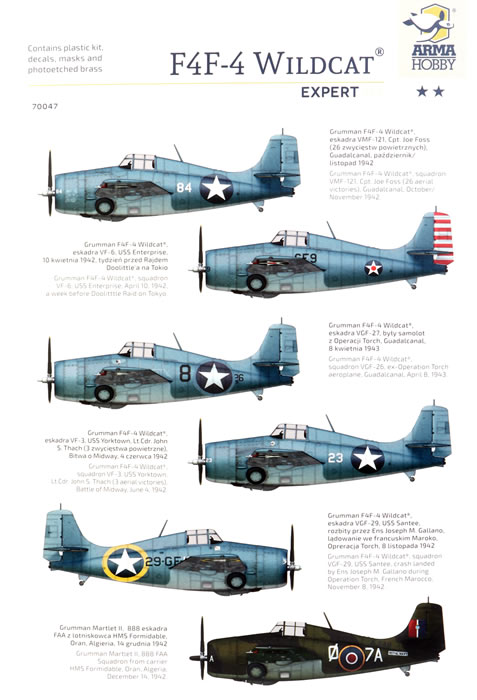
In addition to production by Grumman, General Motors / Eastern Aircraft produced 5,280 FM variants of the Wildcat.
Grumman’s Wildcat production ceased in early 1943 to make way for the newer F6F Hellcat, but General Motors continued to produce Wildcats for both U.S. Navy and Fleet Air Arm use.
Even when the Wildcat was obsolescent as a front line fighter compared to the F6F Hellcat or the much faster F4U Corsair, it remained adequate for small escort carriers against submarine and shore threats. These relatively modest ships only carried two types of aircraft, the Wildcat and GM-built TBM Avenger. The Wildcat's lower landing speed and ability to take off without a catapult made it more suitable for shorter flight decks.*
Arma Hobby released their 1/72 scale Expert Series FM-2 Wildcat in March 2020. This was followed by the lower spec and reduced price Model Kit series FM-2 later in 2020.
Arma Hobby has now released their much anticipated 1/72 scale F4F-4 Wildcat.
In total, this one comprises 80 parts in grey plastic, 14 parts on a single photo-etched fret; self-adhesive canopy and wheel masks; markings for five aircraft and bonus markings for another four options.
The grey plastic parts are delivered on two sprues. Moulding quality is excellent with no flaws or visible moulding imperfections on my sample, only a little flash on some of the smaller parts. Arma’s website advises that long-run metal moulds are used for their kit production, and it really does show.
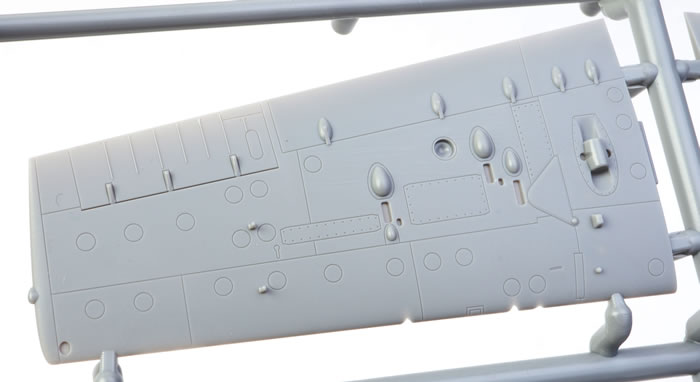
Being a long-run kit, the parts are moulded with all the alignment aids that you would expect including locating pins, holes and tabs.
The larger parts are moulded with a satin finish. Surface textures are just gorgeous. Recessed panel lines, raised fastener heads, blister fairings and other structural details are very fine.
The fabric texture on the rudder, elevators and ailerons are represented by subtly raised rib tapes. The elevators are moulded as a pair so they may be posed to taste. The rudder is a separate part too.
The fuselage is supplied as left and right halves with the standard fin moulded to the fuselage halves.
Some cockpit sidewall detail is moulded directly to the inside of the fuselage. There is also a plastic cockpit floor, front and rear bulkheads, side consoles, a moulded pair of rudder pedals that plug in behind the instrument panel, control column and more.

A plastic instrument panel is also supplied with raised bezels and switches. The decal sheet supplies two sets of harness straps and instrument panels.
The cockpit is supplemented with a number of useful photo-etched parts including an optional brass instrument panel, harness straps, various handles and control chains. The engine ignition harness is also supplied as a single photo-etched part.
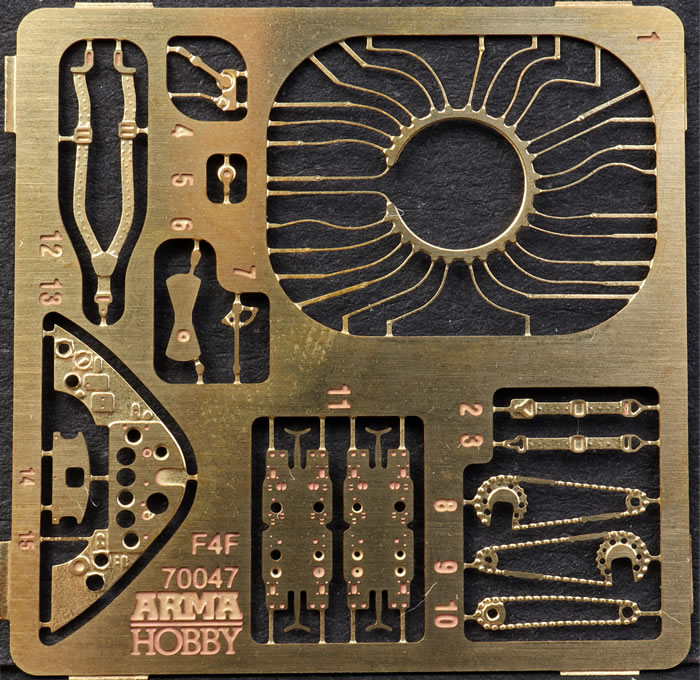
Wheel wells are nicely detailed. The intricate landing gear is cleverly moulded in a minimum number of parts, although care will be required during alignment and assembly. Test fit thoroughly!

Two styles of main wheel are offered, as are two different tail wheel parts – covered and uncovered. The main wheels are subtly bulged and flattened.
The engine is very well done. The two rings of cylinders boast fine cooling fin detail. This is supplemented with pushrods and the crankcase cover. Pushrods are supplied as two parts and the exhaust manifold is another part. Seven decals are included for the crankcase and magnetos.
Alternative crankcase and engine cowlings are supplied for the FAA Martlet Mk.II.

The wings are moulded in four parts with upper and lower, port and standard halves. Trailing edges are very thin – almost translucent.
Two drop tanks wrap up the grey plastic parts. Photo-etched bomb racks are included but bombs are not.
The canopy parts are thin and clear and offer separate parts for the windscreen and the sliding section. The gunsight lens is a clear part too.
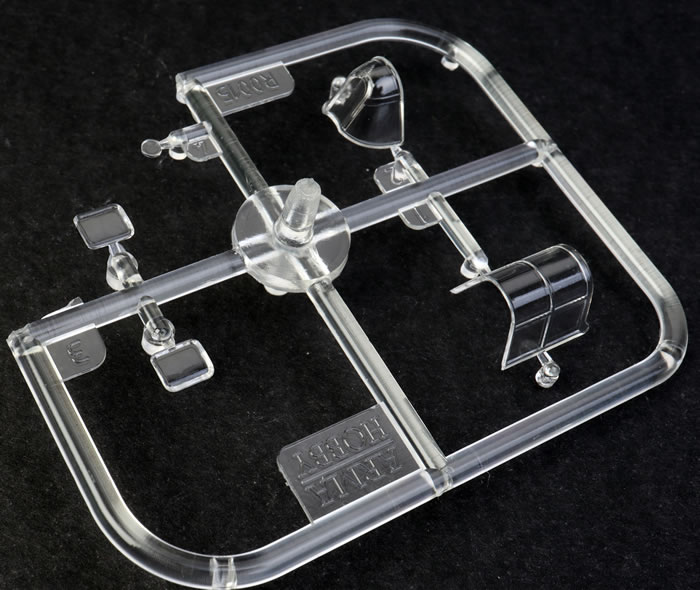
Wing tip navigation lights are moulded as part of the wings.
Self adhesive masks are supplied for the birdcage canopy. This will be welcomed by modellers who dislike cutting their own masks.
Instructions are supplied as a 16 page stapled A5-sized booklet. Some of the assembly sequences are quite complex so make sure you test fit until you are sure where everything goes before you commit to glue (I wish hat I would follow my own advice sometimes...).
The kit is packed into a end-opening cardboard box. I have to say that I have never been a fan of end-opening boxes - access to the parts is more difficult, loose parts can easily be lost while retrieving instructions or a larger sprue, and the format is less structurally rigid, inviting the contents to be crushed when the box is inevitably at the bottom of a pile of kits.
I know it is a nit-pick but I would prefer to see future Arma Hobby releases in a lid-style of box.
Marking Options
Four US Navy and one Fleet Air Arm marking options are offered. The four US Navy aircraft are finished in Blue Grey and Light Grey with a variety of styles of national markings. The FAA Martlet Mk.II is camouflage in Extra Dark Sea Grey and Dark Slate Grey upper surfaces with Sky below.
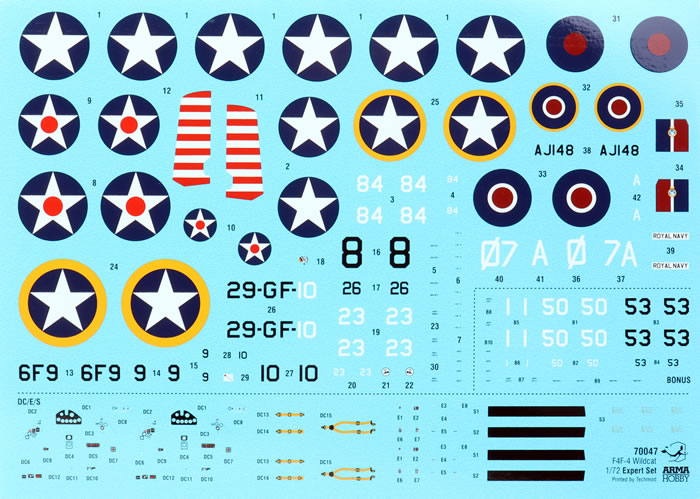
Stencil markings are delivered on the same single sheet, as are black wing walkways and propeller logos.
Colour callouts are provided for FS numbers and model paint numbers from a wide variety of companies – Hakata, AK, Lifecolor, AMMO, Humbrol, Vallejo and Tamiya.
Decals are printed by Techmod. They are glossy, colours are well saturated and everything is in perfect register.
Arma has also supplied bonus decals for another four marking options. Instructions for these four bonus markings are included.
Arma Hobby's 1/72 scale F4F-4Wildcat is a gorgeous little kit - crisp surface texture, high moulding quality and a very high level of detail. It's a great package with the plastic and photo-etched parts as well as self-adhesive masks. What else could we ask for?
* Historical background adapted from Wikipedia
Thanks to Arma Hobby for the sample
Review Text and Images Copyright © 2021 by Brett Green
Page Created 20 September, 2021
Last updated
21 September, 2021
Back to HyperScale Main Page
Back to Reviews Page |
Home
| What's New |
Features |
Gallery |
Reviews |
Reference |
Forum |
Search